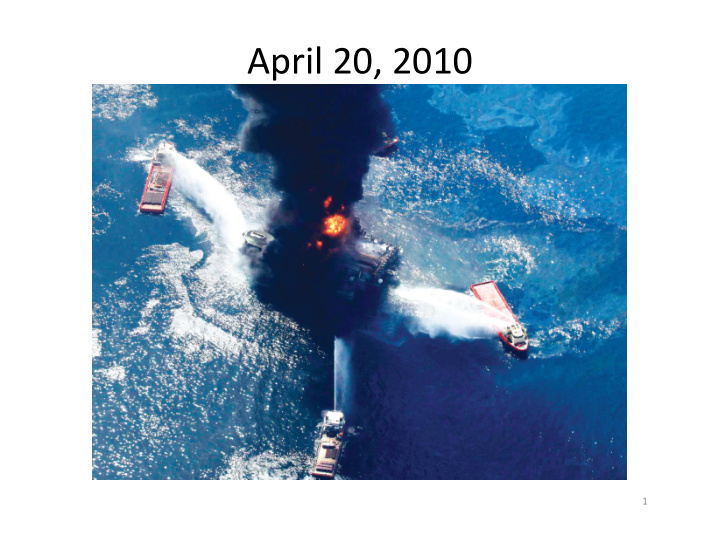



April 20, 2010 1
Slide 1 RJL1 I have added a proposed new picture. The picture you had did not fit the accompanying commentary. It was small scene related to the response action. You need a picture of the initial explosion. Richard.Lazarus, 1/7/2011
National Commission on the BP Deepwater Horizon Oil Spill and Offshore Drilling Report to the President www.oilspillcommission.gov 2
The Macondo well blowout was the product of human error, engineering mistakes and management failures • Failure to adequately evaluate and manage risk in late-stage well design decisions • Failure to redesign cement slurry even after tests demonstrated problems • Failure to stop after “negative pressure test” was unsuccessful three times • Failure to recognize the temporary well-abandonment procedures risky Failure to communicate effectively last minute changes ( plan changed • four times) • Failure to respond to early warning signs of hydrocarbon influx • Failure to trigger BOP until too late
Preventing Accidents: Changing Business As Usual The Compelling Need for a Culture of Safety 4
Preventing Accidents: Changing Government U.S. offshore drilling regulations and enforcement practices should be the most advanced in the world 5
Mitigating Harm: Containment and Response Increased Industry & Government Investment in Spill Response Technology 6
Changing Legislation Raising Liability Caps and Promoting Financial Responsibility 7
Assessing Progress Implementing the Recommendations of the National Oil Spill Commission: Oil Spill Commission Action
Congress D Industry C+ Administration B C Frontier Areas Adequate Resources D Impacts and Restoration C Spill Response and Containment B- Safety and Environmental Protection B and Actors Summary Grades for Key Actions
Examples of Progress Agencies: Safety and Environmental Management System and Drilling Safety Rules DOI Reorganization= BOEM & BSEE BOEM:SOAR and BSEE:OSSR DOI,USCG, NOAA agreements ICCOPR reinvigorated Industry: Industry/NOAA research/data sharing Center for Offshore Safety (API) Marine Well Containment Co and Helix Group Joint Industry Offshore Operating Procedures Task Force (cementing, well design, spill response)
Remaining to be done….
Safety and Environmental Protection • DOI improve its regulatory programs; • CEQ and DOI revise the NEPA process; • The Center for Offshore Safety: operational & independent of API; • Congress codify changes to DOI regulatory structure; • Congress pass legislation incorporating Commission’s recommendations for improving safety and environmental protection.
Spill Response and Containment • Test the capability of new containment systems to deal with large, deep, high pressure spills; • Modify the National Contingency Plan; • Modify dispersant testing protocols; • Fund comprehensive and coordinated federal oil pollution research; • Complete rule to significantly upgrade the BOP requirements; • Formalize the roles of USCG, NOAA, EPA in review & approval of oil spill response plans .
Impacts and Restoration • Congress enact legislation dedicating Clean Water Act penalties for restoration of Gulf of Mexico; • EPA and the Coast Guard modify the oil spill response system to take account of the lessons learned from the Deepwater Horizon spill; • NOAA work with other agencies, industry, stakeholders and the public to build support for Marine Spatial Planning.
Adequate Resources • Make program self-funding: create a dedicated fee system to support effective regulatory operations; • Increase liability cap and financial responsibility requirements for offshore facilities ; • Raise the Oil Spill Liability Trust Fund’s limitation on funds available for federal agencies to respond to a spill.
Frontier Areas • Expand and fund the research necessary to adequately characterize environmental conditions; • Conduct additional research on and demonstrate the ability to prevent, respond to, contain and clean-up oil spills; • Establish regional citizens councils for offshore activity; • Promote the international adoption of standards and procedures for spill prevention and response; • Remove the barriers which could prevent the U.S. from responding to spills in Mexican or Cuban waters
Arctic Recommendations • World class standards for Arctic operations • Spill response equipment, testing, personnel training Infrastructure for deploying equipment and personnel • • Coast Guard assets and capability • Comprehensive, integrated ecosystem research to inform decisions • RCAC for the Arctic • International coordination, cooperation, exchanges, agreements
Arctic Progress • USGS Gap Analysis • NOAA – Industry Science MOU • NOAA Arctic ERMA • NPRB Arctic Science RFP • IARPC 5 year Arctic Research Plan • DOI/NOAA/USCG Spill Review Agreement • President’s Arctic Permitting Working Group EO 13580 • ICCOPR oil pollution research revived • USCG drills and plans for 2012 • National Ocean Council Arctic Plan • Arctic Council EBM • Industry plan and assets
Arctic Council • Arctic Offshore Oil & Gas Guidelines (2009) • Emergency Search & Rescue Agreement (signed May 2011) • Oil Spill Response Draft Agreement (Russia, Norway, USA co chairs) 12 May 2011, the Ministers of the Arctic Council member states decided “to establish a Task Force, reporting to the Senior Arctic Officials, to develop an international instrument on Arctic marine oil pollution preparedness and response, and called for the Emergency Prevention, Preparedness and Response (EPPR) and other relevant working groups to develop recommendations and/or best practices in the prevention of marine oil pollution; the preliminary or final results of both to be presented jointly at the next Ministerial meeting in 2013”.
Oil Spill Commission Action • Further information about Oil Spill Commission Action is available at OSC Action .org . • Further information about the operations and products of the original Commission is available at oilspillcommission.gov . Fran Ulmer UAA April 18, 2012
Recommend
More recommend